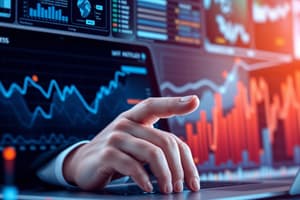Podcast
Questions and Answers
What characterizes the transition in digital transformation from the past to the current scenario?
What characterizes the transition in digital transformation from the past to the current scenario?
- Movement from generative data to non-generative data
- Increased reliance on physical servers instead of cloud technology
- Shift from IT-centric to business-centric frameworks (correct)
- Focus solely on transactional data without analytics
What is the significance of the growth statistic that 90% of the world's data was generated in the last two years?
What is the significance of the growth statistic that 90% of the world's data was generated in the last two years?
- It reflects the diminishing role of data in business
- It indicates the rapid expansion of data generation capabilities (correct)
- It shows a decrease in data relevance over time
- It signifies a stable trend in data creation since 2010
What term describes the combination of Big Data and analytics to produce useful insights?
What term describes the combination of Big Data and analytics to produce useful insights?
- Insight Data
- Smart Data (correct)
- Data Mining
- Small Data
What are systems of engagement and insight primarily used for in digital transformation?
What are systems of engagement and insight primarily used for in digital transformation?
What is the primary role of a data analyst?
What is the primary role of a data analyst?
Which of the following best describes the role of a Data Analyst within a business?
Which of the following best describes the role of a Data Analyst within a business?
Which of the following is a benefit of data visualisation?
Which of the following is a benefit of data visualisation?
How does the Internet of Everything (IoE) affect the physical world?
How does the Internet of Everything (IoE) affect the physical world?
What will the estimated increase in data generation look like from 2023 to 2025?
What will the estimated increase in data generation look like from 2023 to 2025?
Why is visual information more effective than text?
Why is visual information more effective than text?
What tool do data analysts use to share their findings?
What tool do data analysts use to share their findings?
Why is it incorrect to associate Big Data solely with its size?
Why is it incorrect to associate Big Data solely with its size?
What does data visualisation primarily involve?
What does data visualisation primarily involve?
How does Spotify utilize data analytics?
How does Spotify utilize data analytics?
Which statement about data analytics is correct?
Which statement about data analytics is correct?
What is one of the primary objectives of data analysis?
What is one of the primary objectives of data analysis?
Flashcards
Data Analytics
Data Analytics
The process of finding hidden patterns and trends in data. It involves analyzing large datasets, identifying correlations, and making estimations based on the insights gained.
Data Visualization
Data Visualization
Using visual elements like charts, graphs, and maps to represent data and find patterns.
Data Analyst
Data Analyst
A professional who analyzes data to understand trends and insights. They use various tools and techniques to visualize and communicate their findings.
Categorical Data
Categorical Data
Signup and view all the flashcards
Numerical Data
Numerical Data
Signup and view all the flashcards
Business Analytics
Business Analytics
Signup and view all the flashcards
Big Data
Big Data
Signup and view all the flashcards
Spotify's Personalized Playlists
Spotify's Personalized Playlists
Signup and view all the flashcards
Digital Transformation
Digital Transformation
Signup and view all the flashcards
Business-centric Digital Transformation
Business-centric Digital Transformation
Signup and view all the flashcards
Internet of Everything (IoE)
Internet of Everything (IoE)
Signup and view all the flashcards
Smart Data
Smart Data
Signup and view all the flashcards
Data Creation Growth
Data Creation Growth
Signup and view all the flashcards
Study Notes
Digital Transformation
- Digital transformation is one of the most transformational times in human history.
- This involves changes in how IT-centric systems are evolving to a more business-centric approach.
- The past involved IT-centric systems of record, traditional applications, transactional data and reporting and the Internet, all non-generative.
- The current model involves more business-centric strategies.
- Systems of engagement and insight are now more common, as are cloud-native applications.
- Data streams and the internet of everything are key elements of this shift.
- Generative approaches are also being employed.
Data Creation Growth Statistics
- 402.74 million terabytes of data are created daily.
- This includes data that is newly generated, captured, copied or consumed.
- In zettabytes, this equates to approximately 147 zettabytes per year, 12 zettabytes per month, 2.8 zettabytes per week or 0.4 zettabytes per day.
- The amount of data generated annually has been increasing year-over-year since 2010.
- 90% of the current global data was generated in the past two years.
- in 2010 alone, there were just 2 zettabytes.
- In 13 years, this has grown 74 times.
- 120 zettabytes of data was made in 2023, projected to grow over 150%in 2025, hitting 181 zettabytes.
Demand for Data Analysts
- A high demand for data analysts exists in the current job market.
- The role of a data analyst is to analyze and gain insights from large data sets.
- Data analysts are high in demand globally.
The Internet of Everything
- The Internet of Everything (IoE) is transforming the world into an intelligent world. This now includes devices that are data-enabled.
What is Big Data?
- Big data is a large and complex set of data that is difficult to process using traditional database management tools.
- Challenges include capture, curation, storage, search, sharing, analysis, and visualisation.
- Big data resembles small data, though is considerably larger.
Big Data vs Smart Data
- Big data is not about quantity of data, it's about its qualitative value.
- By adding analytics, these large data sets develop into smart data.
Data Visualisation
- The visual display of data, like charts or graphs makes data easily comprehensible.
- This aids to uncover patterns, trends, and associations within the data
- Visualisations are used to display findings to key stakeholders, leading to data driven decision-making.
Types of Data
- Structured Data - data with a fixed structure like Excel spreads or databases.
- Semi-Structured Data - data without a fixed structure but contains tags or other markers, such as emails.
- Unstructured Data - data without any recognisable patterns or structure, such as images or audio.
Data Analytics - The Process
- Data Analysis involves steps such as aggregating, enriching, presenting, and informing the basis for decisions.
- It includes a range of tools, both database, data mart, data warehouses, and ETL.
- These help to integrate data from various sources.
Data Analytics - Tools
- A variety of tools are available to aid data analysis, including various programming languages(e.g. PYTHON, R, SQL).
- Also include statistical packages (e.g. SAS, SPSS) and data analysis tools (e.g. Tableau, Excel, Qlik Sense).
Analytics for Business – Examples
-
Market Basket Analysis - the study of grouping items that consumers frequently buy to learn how these items align and for use in marketing and promotion.
-
Cluster Analysis - identifying group patterns from data, used in marketing, land use, and other areas.
-
Decision Tree Analysis - a flowchart like model that shows a series of decisions and their outcomes that assist in making logical decisions. -Decision trees are used for credit applications, business investments, and product launch planning.
Big Data Case Studies
- Examples of companies that have used Big Data include UPS and Dell.
- The results of such analysis include saving money, increasing efficiency, and better decision-making.
Studying That Suits You
Use AI to generate personalized quizzes and flashcards to suit your learning preferences.




